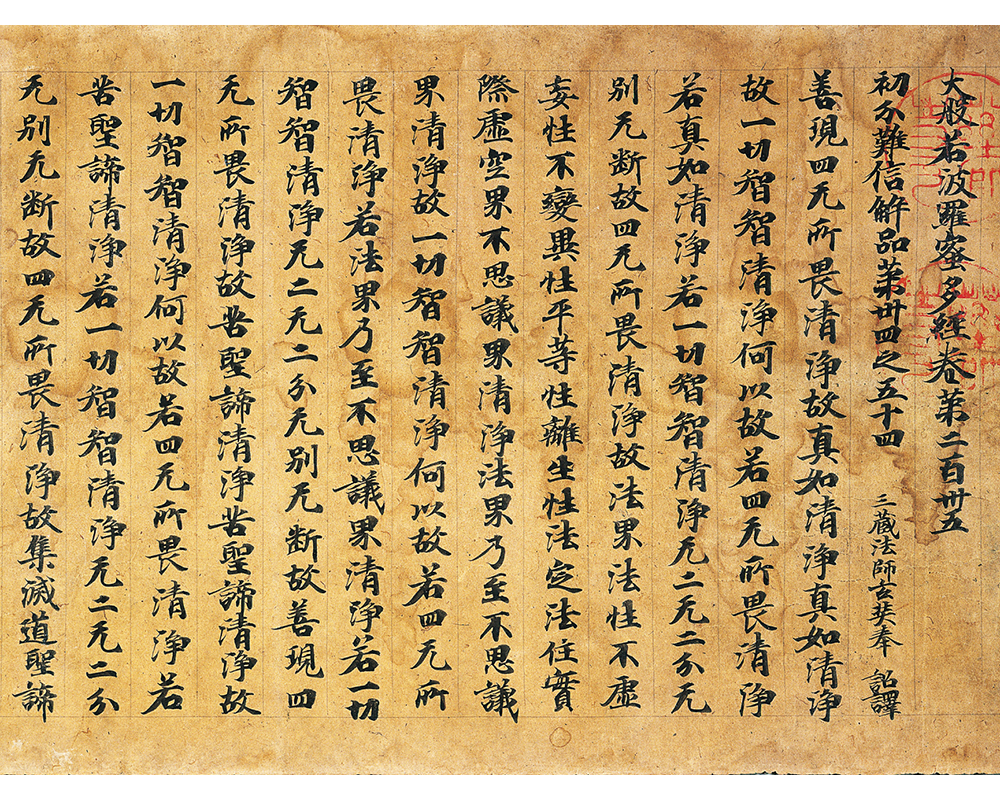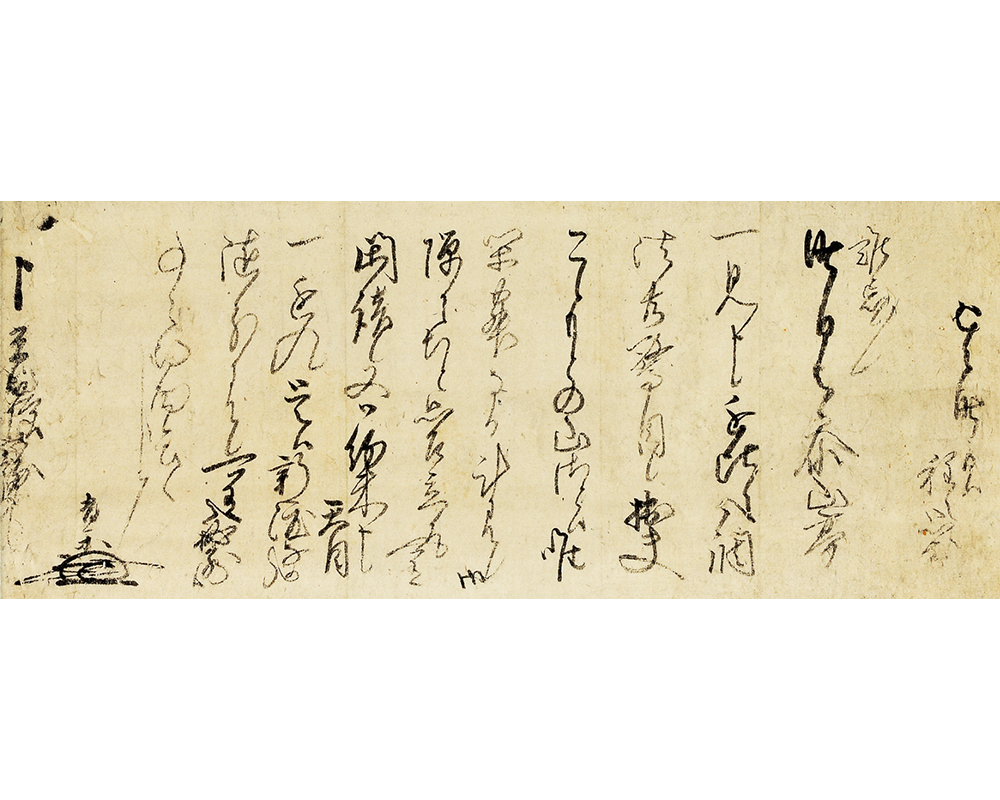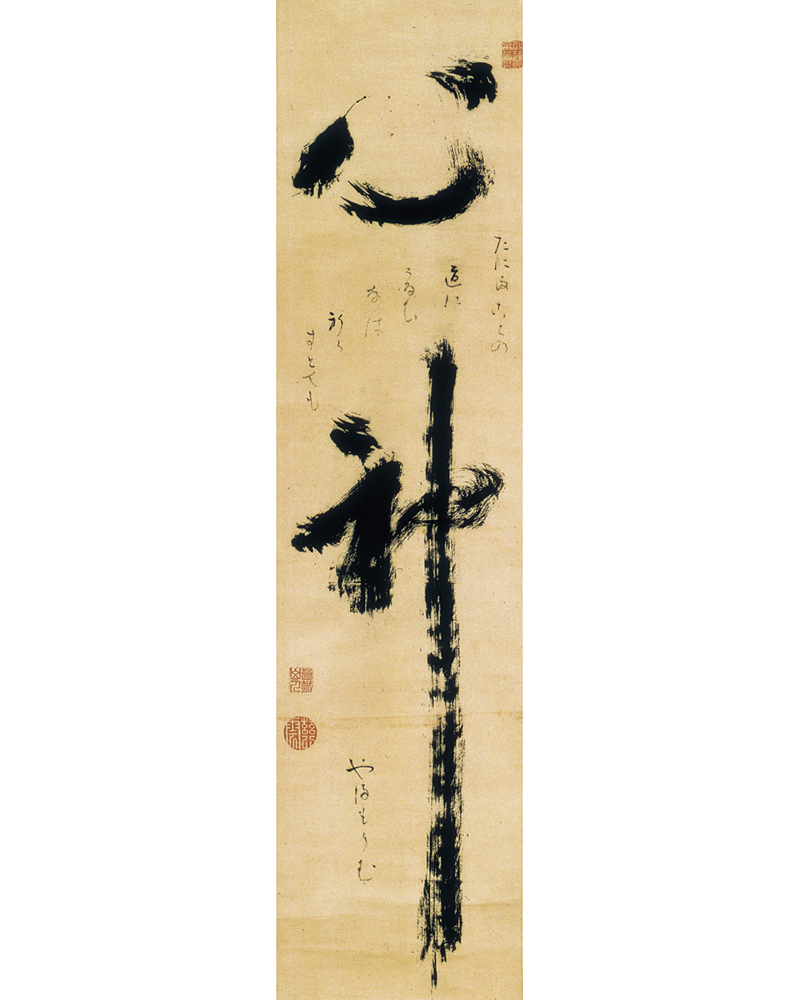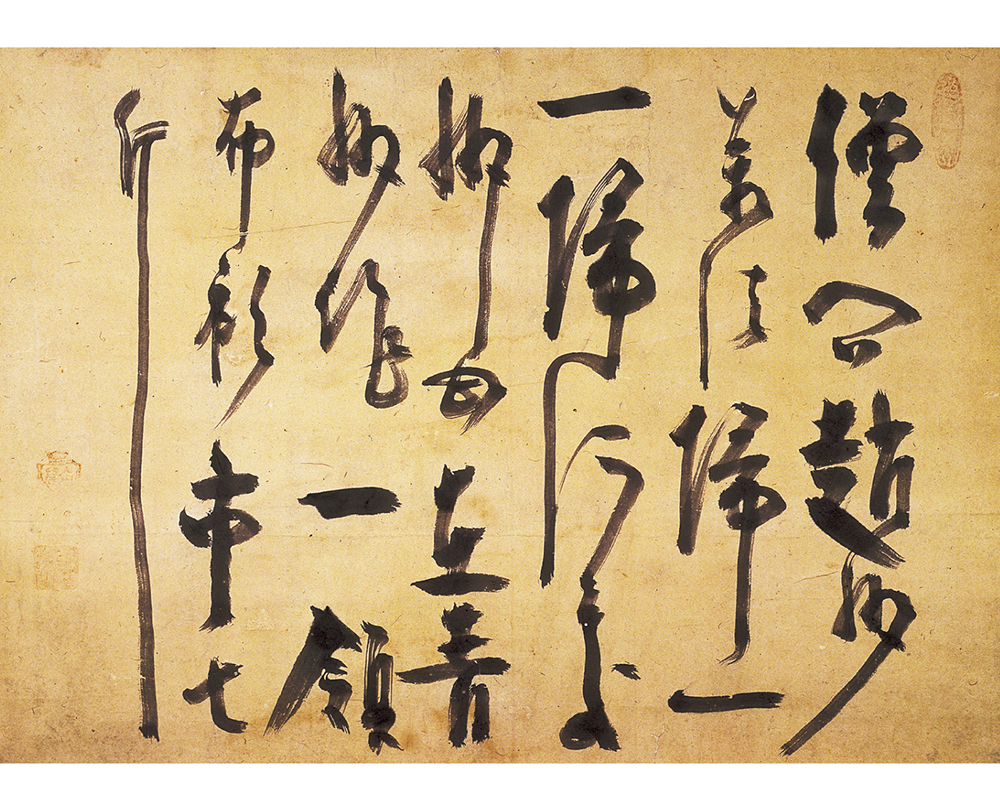Great Prajnaparamita Sutra Scroll
(Daihannyahara Mitakyo)
Specific information
Important Art Objects
author
Tradition: Nakai
Country
Japan
Era
Nara period (8th century)
Traits
Ink on paper
Number of members
Volume 1
Law
27.3cm long x 1038.5cm wide
Commentary
This is a surviving scroll of the Great Perfection of Wisdom Sutra, representative of the late Nara period. It is called the "Yakushiji Sutra" because it was brought to Yakushi-ji Temple, and is also called the "Gyoyo Sutra" because it was addressed to Asano Gyoyo, a talented calligrapher at the time. In fact, it is thought to have been copied by a dozen or so students at the government-run sutra copying studio at Todai-ji Temple around the beginning of the Hoki era (770-). The somewhat large, bold, and voluminous style of writing is a characteristic of sutra copying in the late Nara period. The writing paper is high-quality yellow Hishi (ganpi paper) and has been extremely well preserved, and both the brown Hishi cover and the white mitsuda-shaped scroll are from the original.
The Amitabha Sutra
(BUSSETSU AMIDAKYO)
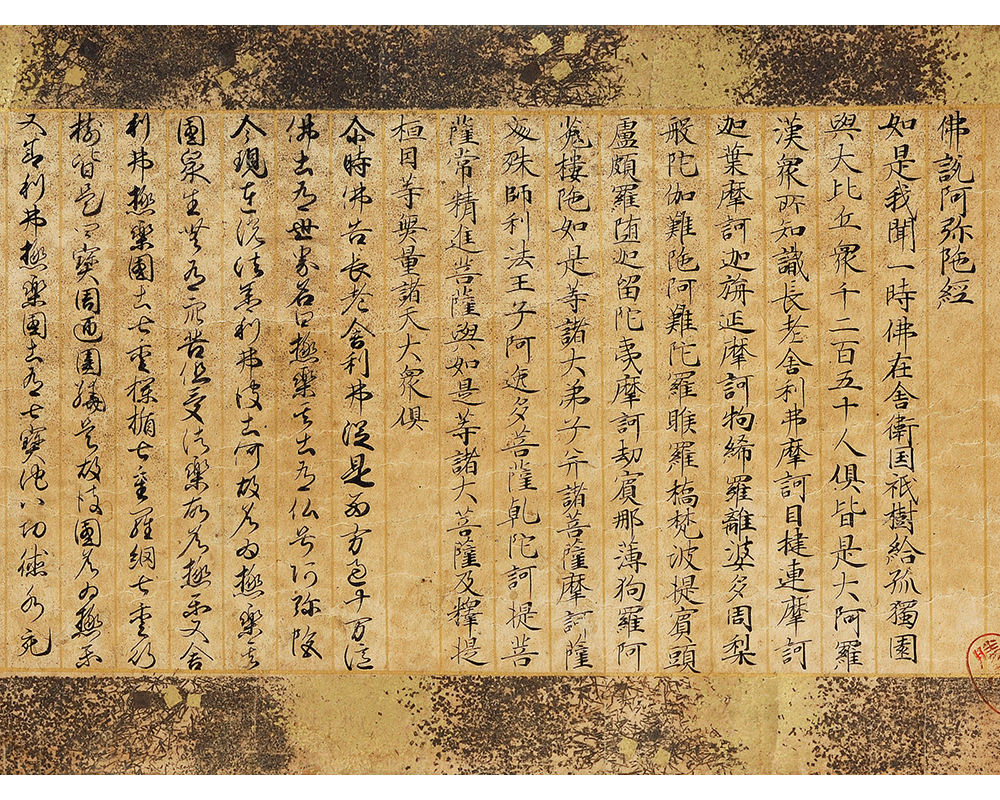
Specific information
Important Art Objects
Country
Japan
Era
Heian period (11th-12th century)
Traits
Colored ink calligraphy
Number of members
Volume 1
Law
27.0 cm long x 230.6 cm wide
Commentary
Towards the end of the Heian period, along with political instability, the idea that this world was one in the Latter Days of the Law, when Buddhism was declining, spread. Heian-era aristocrats had faith in Amida Buddha in the hope of being reborn in paradise, and this was expressed in sculptures, paintings and copying of sutras. The Amida Sutra teaches that one can be reborn in the Pure Land by simply chanting the name of Amida Tathagata, and was actively copied by aristocrats. This is an ornamental sutra, with gold borders drawn on hishi paper and large and small gold and silver foil scattered around the margins, and it is unusual in that the first eleven lines are written in regular script, with the rest in a mix of semi-cursive and cursive script. The endpapers, scrolls and cover were added later.
The Unfailing Dharma Wheel Sutra
(Two-tiered tribute council)
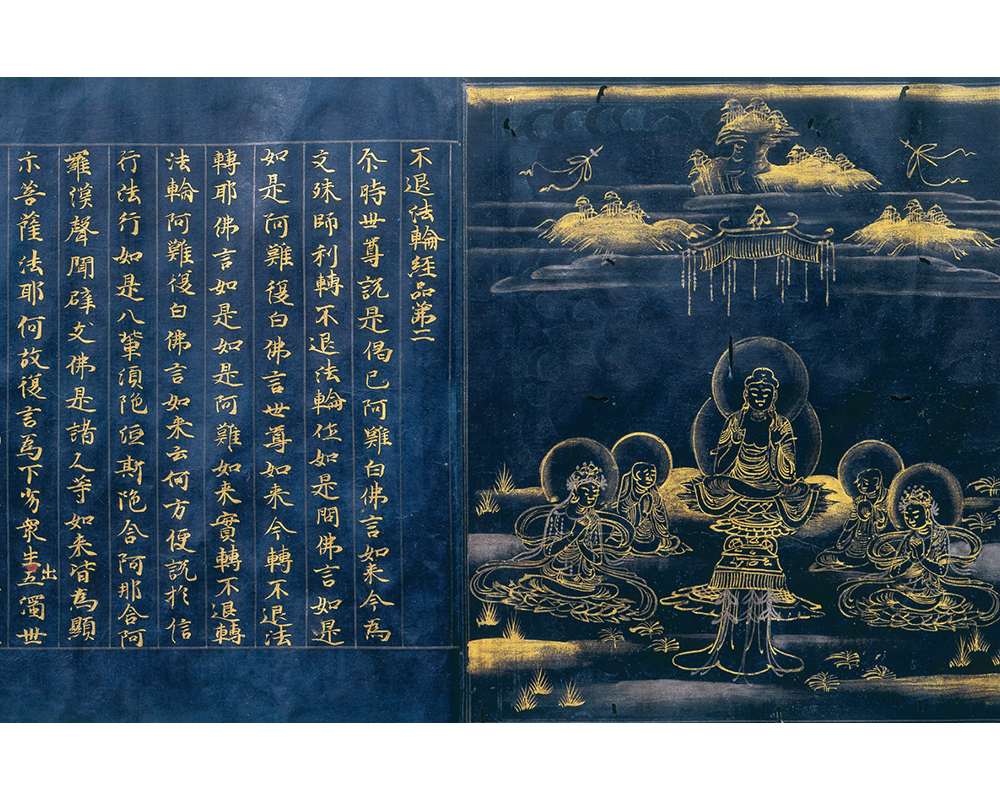
Specific information
Important Art Objects
Country
Japan
Era
Heian period (12th century)
Traits
Navy blue paper with gold lettering
Number of members
Volume 1
Law
25.8cm long x 300.8cm wide
Commentary
This sutra scroll has the sutra copied in gold letters on dark blue paper. The inside cover depicts Shakyamuni preaching beneath Mount Vulture Peak, accompanied by attendants and two bodhisattvas, showing the world of the Pure Land. The cover features a treasure flower, symbolizing the Buddha's merit, rendered in gold and silver paint, and the original colors of both the calligraphy and the painting remain beautifully preserved. The scroll and string are also from the time, and the end of the gilt bronze scroll is decorated with a four-petal treasure flower pattern. It has been designated an Important Cultural Property as the so-called Chusonji Sutra, which was commissioned by the Fujiwara clan of Oshu, but due to differences in the style of writing in the main text and the expression of the painting on the inside cover, it is thought to be a typical example of the complete sutras in gold letters on dark blue paper, which flourished in the 12th century.
Old and new list guide
(Children's Directory Mirror)
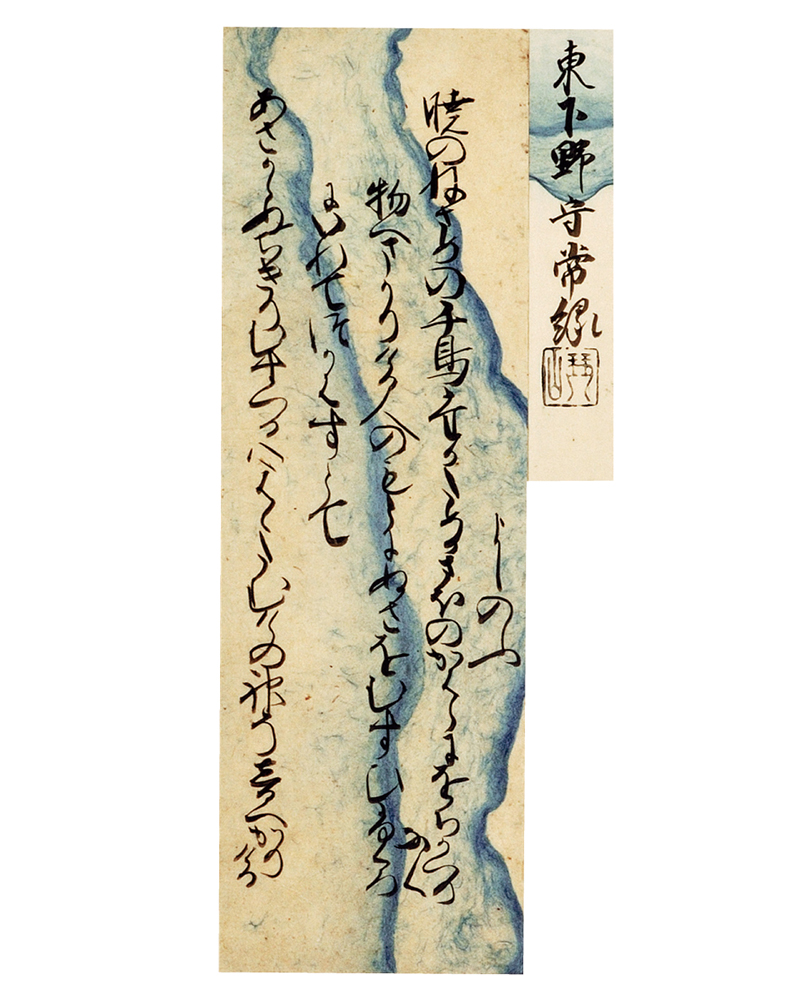
Specific information
Important Art Objects
Country
Japan
Era
Nara period to Edo period (8th to 18th centuries)
Traits
Paper book, colored calligraphy
Number of members
1 tatami
Law
39.5cm long x 32.0cm wide
Commentary
A tekagami is a collection of famous calligraphy from ancient times to the present, used as a sample for practicing calligraphy. In the early modern period in particular, it was highly valued as a tool for handwriting analysis, and many tekagami were made. This item is a tekagami that contains 299 pieces of ancient calligraphy and short strips of paper from the Nara period to the early Edo period. It comes with the certificates of ancient calligraphers, including Ryosa, the first of a family of ancient calligraphers who flourished as a handwriting analysis family.
-----
Collection of Waka Poems, Volume 8, Fragment
Attributed to Tono Tsuneen
Colored calligraphy, Muromachi period (15th century)
The work in the image is a leaf included in the Koshin Ichiran Techo. The author has a tradition of Azuma Tsuneen (1401?-1484), a military commander and poet of the Muromachi period. The Azuma family is descended from Fujiwara no Teika, and became a disciple of Azuma Takataka, a scholar of the Nijo school of waka poetry that had existed since their forefathers. His lecture on the Kokin Wakashu to the renga poet Iio Sogen in 1471 is said to have been the beginning of the transmission of the Kokinshu. The writing paper is indigo cloud paper.
Letter from Oda Uraku to Komyoin Gobo
(Odaura Kutagawa, Minister of Foreign Affairs, Gobou Ate)
author
Oda Uraku
Years of birth and death
1547-1621
Country
Japan
Era
Edo period (17th century)
Traits
Ink on paper
Number of members
1 width
Law
24.1cm height x 59.5cm width
Commentary
Oda Uraku Nagamasu was the younger brother of Oda Nobunaga. He skillfully survived the turbulent times from the Honnoji Incident to the establishment of the Tokugawa government, and retired to Higashiyama, Kyoto, after the Winter Siege of Osaka. He was counted among the Seven Philosophers of Rikyu, and spent the rest of his life as a connoisseur of fine ware. The contents of the letter were to thank him for his visit and to convey his promised gift of a Chinese Tenmoku tea bowl. The phrase "this mountain town" in the letter could be taken to refer to Joan, a teahouse that was built in Shoden-in, a subtemple of Kennin-ji Temple, from 1625 onwards, so this letter is believed to have been written in his later years.
Sugawara no Kamisho's poem
(Tourism guide)
author
JIUNONKO
Years of birth and death
1718–1804
Country
Japan
Era
Edo period (18th century)
Traits
Ink on paper
Number of members
1 width
Law
112.7cm long x 28.0cm wide
Commentary
He writes poems by Sugawara no Michizane. A "god" is drawn down in a single stroke to a tranquil "heart." Small kana characters are scattered throughout the space. Jion Inko was a high-ranking Shingon Buddhist monk in the Edo period. Born in Osaka, he was ordained at Horaku-ji Temple in Tanabe, Osaka, and later became the chief priest of Koki-ji Temple on Mount Katsuragi in Kawachi. Until his death at the age of 87, he sought to uphold the ideal of having the same food, clothing, and language as Shakyamuni did in life, and devoted himself to putting this into practice. Revered across sects, he was known as the "Modern Shakyamuni" during his lifetime, and revered as the Venerable after his death. All of his calligraphy conveys Jion's noble spirit.
The Sekkōroku Kaien Tenmō General Theory
(Sokkoro-Riku Kaien-Setsu)
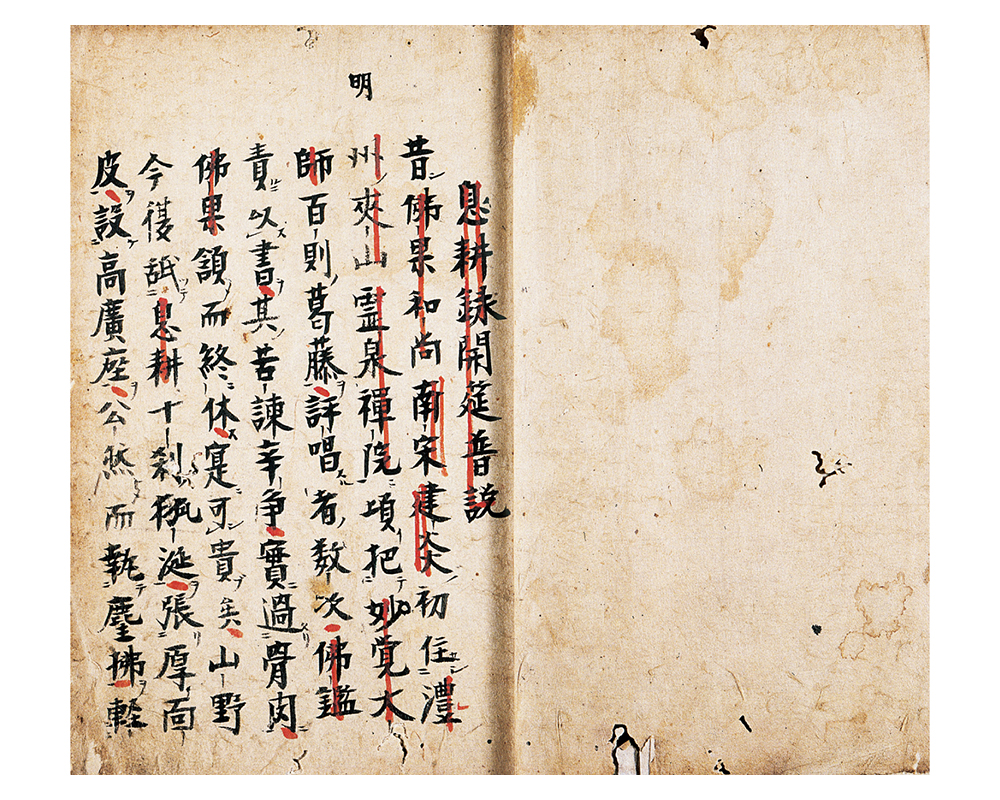
author
Hakuin Ekaku
Years of birth and death
1685-1768
Country
Japan
Era
Edo period, Genbun 5 (1740)
Traits
Ink on paper
Number of members
1 book
Law
Length 26.5cm x Width 17.8cm
Commentary
Hakuin Ekaku was born in Numazuhara. He became the head priest of Numazu Shoin-ji Temple at the age of 33, and in his later years he opened Ryutaku-ji Temple in Izu Mishima. Although he was a man of great virtue, he wore ink-dyed robes throughout his life. He explained Buddhism in simple terms through his own calligraphy and paintings, and was revered beyond his social status. Sokuko was the pseudonym of Kyodo Chigu, a Zen monk from the Southern Song Dynasty in China. Kaisen means to open a lecture, and fusetsu means to widely gather scholars and preach. In the spring of his 56th year, Hakuin proposed "Kyodo-roku (Sokuko-roku)" at Shoin-ji Temple, attracting over 400 people and making him famous. This is a draft of the preface written at that time. It is a major treatise that gives a glimpse into Hakuin's attitude throughout his life, from his upbringing to the state of the Zen world at the time and his views on Zen Buddhism.
Zen word "Monk Questioning Zhaozhou"
(The whole story is "Sojo Shuunito").
author
Hakuin Ekaku
Years of birth and death
1685-1768
Country
Japan
Era
Edo period (18th century)
Traits
Ink on paper
Number of members
1 width
Law
47.9cm long x 61.8cm wide
Commentary
This is a dialogue about the origins of Zen between the Chinese Tang Dynasty Zen monk Zhaozhou Cong'an (778-897) and a monk. A koan from the Zhaozhou Record. Monk: "Everything can be traced back to one fundamental principle. Where can that principle be traced back to?" Master: "When I was in Qingzhou, I made a linen robe that weighed seven jin." This explains the state of mind of Zen training that is not bound by the myriad laws or the weight of the robe.
